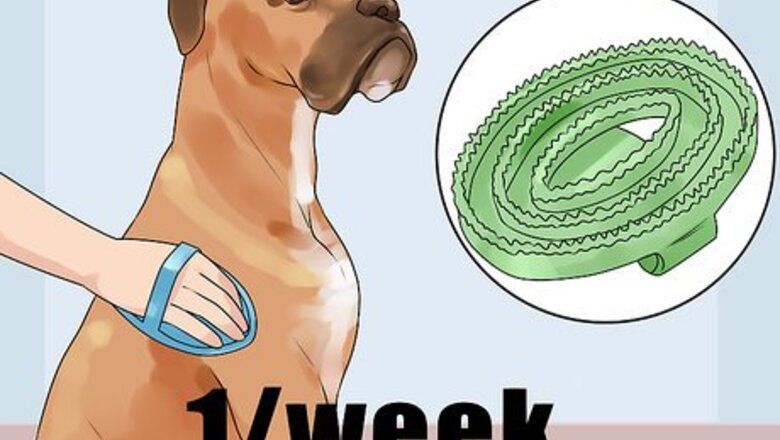
views
Performing Routine Maintenance
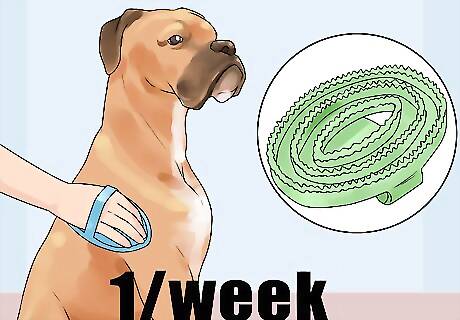
Brush your APBT’s coat at least once a week. Use a rubber curry brush or a soft-to-medium bristle brush with short, dense bristles to groom your pet daily to weekly. Brush its fur in the direction of growth to remove loose hair, enhance its circulation, and distribute its skin’s natural oils. Go over your dog's back, the top of its neck, and the front of its legs. Brush gently on more sensitive areas such as the bottom of its neck, stomach, or back of its legs. Besides keeping your pittie’s coat healthy and lustrous, brushing helps control shedding and dust by removing hair and dead skin cells.
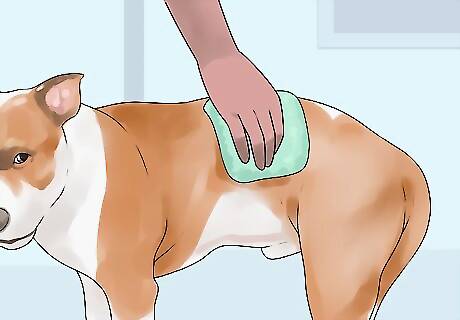
Wipe its coat. Use a damp, clean cloth to wipe your APBT’s fur after brushing. Be sure to move from its neck to its tail, following the grain of its fur. Press firmly enough to remove any lingering hair or dirt, but do not rub. Rubbing or scrubbing your pittie’s fur will encourage any dirt or debris in its coat to cling to its skin instead of removing it.
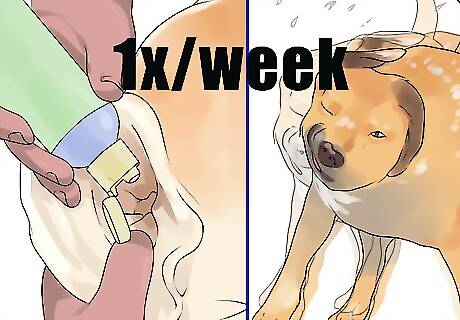
Clean your APBT’s ears once a week. Pitties have perky ears that are susceptible to infections, especially if they’re cropped. Keep your pet’s ears clear of wax and dirt by cleaning them with a mild canine ear cleaner. Since your dog will want to shake its ears after you clean them, you may want to do this outside to avoid a mess. Drip just enough cleaner into your APBT’s ear canal to fill it. Then, massage the base of your pet’s ear for 10-20 seconds, making circular motions with your pointer and middle fingers. Once you’ve massaged the ear, let your dog shake its head to release the cleaning solution and whatever debris it has loosened. Gently wipe any liquid, dirt, and wax out of the ear you’ve just cleaned using a clean cotton ball, then repeat the whole process on the other ear. To prevent any damage to your pet’s inner ear, avoid using cotton swabs or poking anything into its ear canal. While you’re at it, be sure to watch out for any symptoms of infection, such as redness, rashes, swelling, discharge, or foul smells. If you do notice any of these signs, make an appointment with your vet.
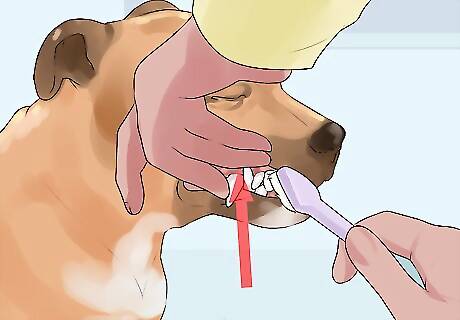
Brush its teeth at least once a week. Regular oral hygiene is important to keeping your pittie clear of bad breath, tartar buildup, and bacterial infections. Start by getting canine toothpaste and an angled canine toothbrush that is sized appropriately for your APBT. Push up your APBT’s lips to expose its teeth, and brush them quickly with a gentle circular motion along the gumline. You only need to do the front side of your dog’s teeth. Do not use human toothpaste. It can be poisonous or harmful to dogs, especially if it contains fluoride or baking soda. Dog toothpaste doesn’t need to be rinsed and comes in meaty flavors that your pet will enjoy. It’ll make this grooming task much easier for you and your pooch. You can also help prevent plaque buildup by feeding your dog dry kibble and giving it dental chews.
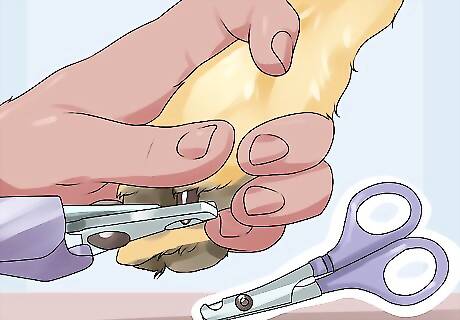
Trim its nails about twice a month. Clipping your APBT’s claws will keep them from cracking or breaking. The frequency will depend on your dog’s activity level and environment. Use a scissor-like Miller’s Forge trimmer designed for medium-sized dogs, and have some styptic powder handy in case you accidentally cut the quick. Before you try clipping your pit bull’s nails, get it used to having its paws handled. Praise your dog and offer treats when it allows you to touch or hold its feet. Pick a time when your dog is tired and relaxed, such as after a walk or feeding. That way, it’ll be less likely to squirm. Go paw by paw. Take one of your dog's paws, holding the foot firmly by the ankle in the palm of your hand. Look for the “quick,” a nerve ending in the underside of your pet’s claw. The quick is only visible on dogs with light-colored nails. Only clip the tip of the nail that extends beyond the quick. Play it safe by erring on the side of leaving too much rather than painfully cutting the quick. If your pittie doesn’t like to have its paws touched or is squeamish, clipping its nails might be a 2-person job. Have one person hold your dog and speak to it reassuringly while the other trims. If that doesn’t work, consider leaving this task to a professional. If you accidentally cut the quick or see blood, firmly press the styptic powder into the end of your pittie’s nail to stop the bleeding. Keep your dog still and reassure it that it's all right.
Bathing Your Pit Bull
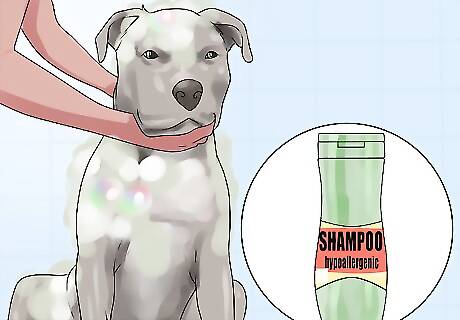
Choose the right shampoo. It’s best to get a mild, hypoallergenic dog shampoo since human shampoos can easily irritate canine skin. It should be free from fragrances and synthetic chemicals. Alternatively, you can make your own dog shampoo by mixing together 1/3 cup (80 ml) glycerin, 1 cup (about .25 liters) mild dishwashing soap, 1 cup (about .25 liters) white vinegar, and 1 quart (about 1 liter) water. Put all these ingredients into a liter-sized bottle, and shake before each use.
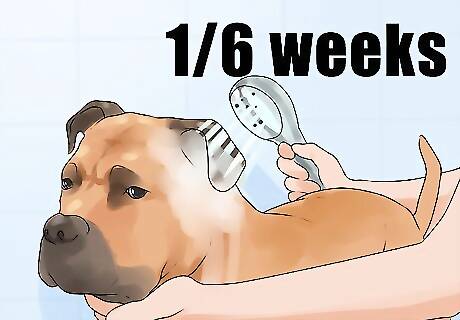
Bathe your APBT infrequently. Frequent washing will dry out a pittie’s skin and deplete the natural oils in its coat. With their fine fur, most APBTs only need a couple of baths per year. You should bathe your pet only when necessary and no more than every 6 weeks unless otherwise directed by a vet. If your dog gets dirty frequently, stick to rinsing off the mud with plain water rather than bathing it more often. You can also spot-clean parts of your dog that get dirty easily (such as the rear end or the feet) with pet wipes. You can bathe your dog in a tub, shower, or outside using a hose with a gentle spray nozzle. Your pooch will be more likely to stay put if you wash it in a controlled or closed space using a comfortably warm water temperature. It’s a good idea to brush your pittie ahead of time to remove any loose hair or dirt before it jumps in the bath.
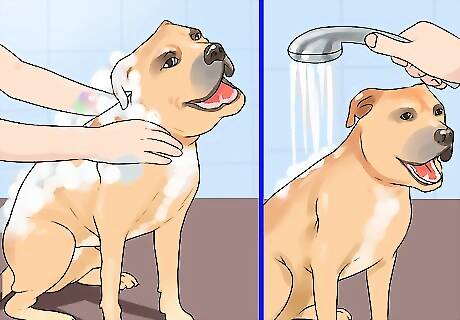
Lather and rinse its coat. Wet and lather up your pittie with dog shampoo from its neck down. Lather up your dog’s head last, taking care not to get soap and water in the eyes and ears. Rinse your pooch with lukewarm water using a detachable shower head, pitchers of water, or a hose with a gentle spray nozzle. Rinse the head first, working your way back over the rest of the body. Be sure to rinse your APBT’s coat thoroughly until the water runs clear so that there’s no shampoo left to dry out its skin or tempt your pet into licking it.
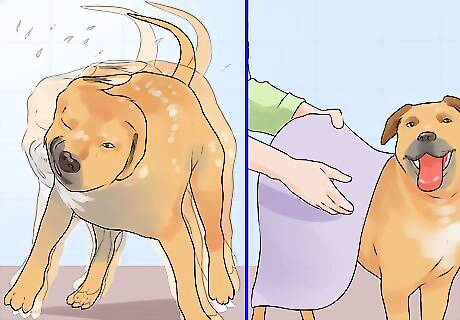
Dry your pittie. Once you’ve given your dog a good rinse, let it shake off any excess water. Then, wrap your pet in a big, absorbent towel, and gently pat it dry. Do not let your dog out into cool weather until it has dried completely. An APBT’s short, single coat and low body fat mean that it can get cold very easily.
Addressing Skin and Fur Problems
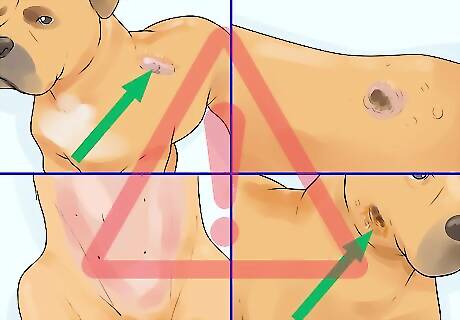
Be on the lookout for skin issues. Pit bulls are prone to certain skin conditions, like mange and allergies. Skin issues can seriously affect the condition of your dog’s coat, making it dry, dull, and/or flaky. Sometimes bathing and grooming can exacerbate these issues instead of curing them. As you groom your dog, keep an eye out for visible irritations, like sores, scabs, rashes, or hot spots.

Take your pittie to the vet if you have any concerns. If you notice symptoms of skin issues that are chronic, severe, and/or widespread, make an appointment with your veterinarian. Skin irritations could be a result of allergies or a symptom of more systemic issues like an immune or gastrointestinal disease. A vet can help you diagnose the causes of skin issues and prescribe treatments to address the underlying conditions. Vets can also help identify the causes of frequent itching. If your pittie itches all year round, it may have an environmental or hereditary allergy. If its itching tends to take place at a particular time of year, it likely has a seasonal allergy. If it’s constantly itching for short, intense periods, your APBT may have fleas. If your pitbull has ongoing skin issues, have your vet refer you to a board-certified veterinary dermatologist.

Give your APBT the right nutrition. You can help keep your pittie’s coat and skin healthy by feeding it a diet that’s rich in essential fatty acids, such as vitamin E, omega-6, and omega-3. Check to see that your regular pet food contains these plant- and meat-based nutrients. Most high-quality “complete and balanced” dog kibbles will already contain essential fatty acids. If yours doesn’t, consider giving your pittie a fish oil supplement to boost its omega-3 intake. Talk to your vet before giving your dog fish oil or other supplements. They can tell you how much to give your dog and recommend supplements that are specially formulated for dogs.

















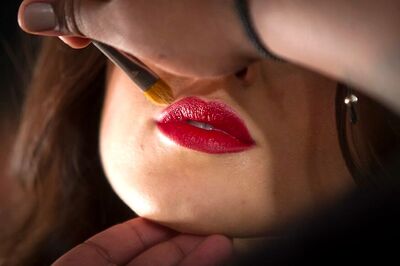


Comments
0 comment